Furnace Repair Leeds
Top 10 Furnace Repair in Leeds
Receive up to 3 Furnace Repair quotes for your project today! Compare profiles, reviews, accreditations, portfolio, etc... and choose the best deal.
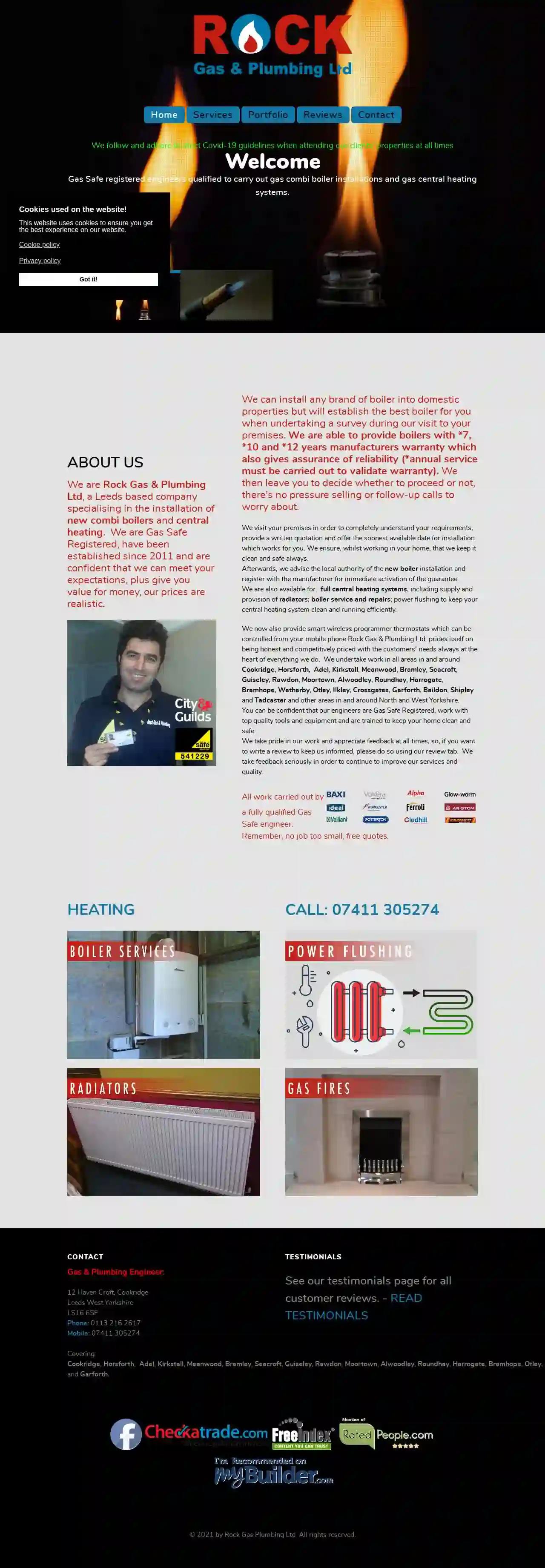
ROCK GAS & PLUMBING LTD
528 reviews12 Haven Croft, Leeds, LS16 6SF, GBWelcome to Rock Gas & Plumbing Ltd, a Leeds based company specialising in the installation of new combi boilers and central heating. We are Gas Safe Registered, have been established since 2011 and are confident that we can meet your expectations, plus give you value for money, our prices are realistic. We can install any brand of boiler into domestic properties but will establish the best boiler for you when undertaking a survey during our visit to your premises. We are able to provide boilers with *7, *10 and *12 years manufacturers warranty which also gives assurance of reliability (*annual service must be carried out to validate warranty). We then leave you to decide whether to proceed or not, there's no pressure selling or follow-up calls to worry about. We visit your premises in order to completely understand your requirements, provide a written quotation and offer the soonest available date for installation which works for you. We ensure, whilst working in your home, that we keep it clean and safe always. Afterwards, we advise the local authority of the new boiler installation and register with the manufacturer for immediate activation of the guarantee. We are also available for: full central heating systems, including supply and provision of radiators; boiler service and repairs; power flushing to keep your central heating system clean and running efficiently. We now also provide smart wireless programmer thermostats which can be controlled from your mobile phone. Rock Gas & Plumbing Ltd prides itself on being honest and competitively priced with the customers' needs always at the heart of everything we do. We undertake work in all areas in and around Cookridge, Horsforth, Adel, Kirkstall, Meanwood, Bramley, Seacroft, Guiseley, Rawdon, Moortown, Alwoodley, Roundhay, Harrogate, Bramhope, Wetherby, Otley, Ilkley, Crossgates, Garforth, Baildon, Shipley and Tadcaster and other areas in and around North and West Yorkshire.
- Services
- Why Us?
- Accreditations
- Our Team
- Testimonials
- Gallery
Get Quote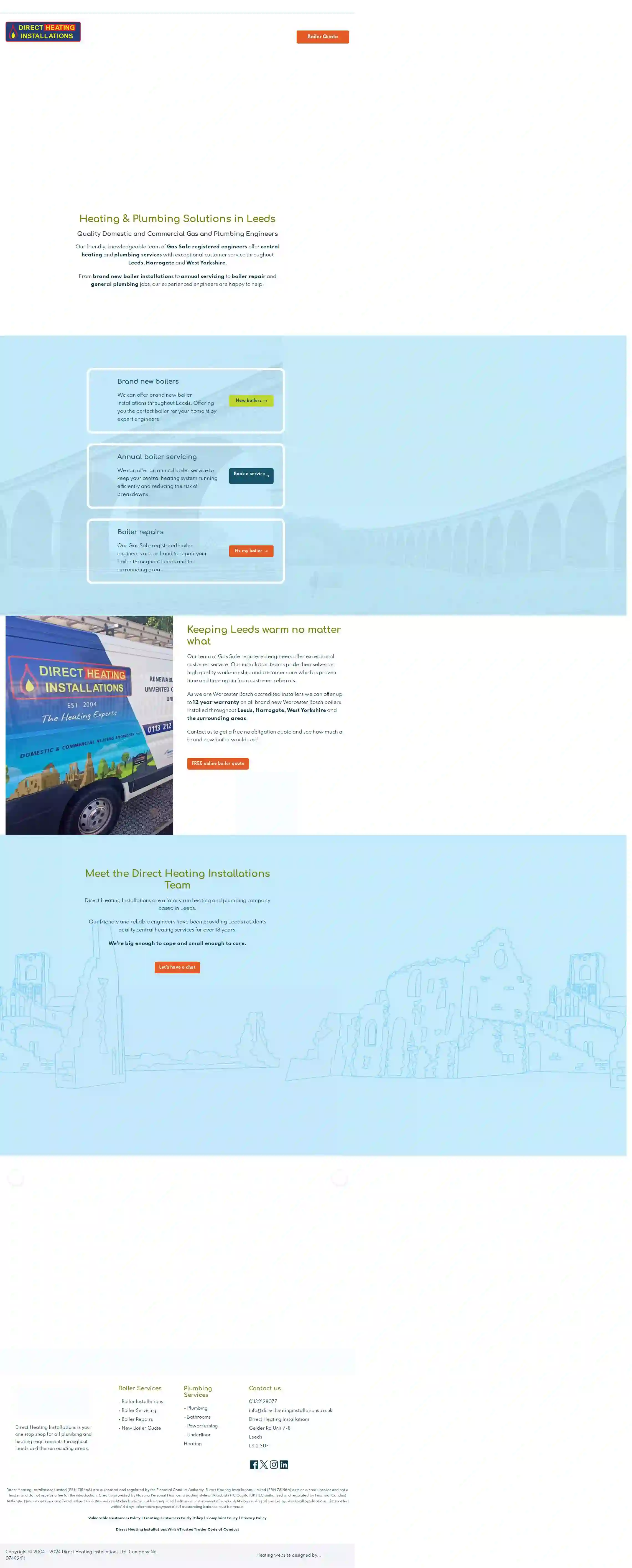
Direct Heating Installations
4.939 reviewsGelder Rd Unit 7-8, Leeds, LS12 3UF, GBDirect Heating Installations is a family-run heating and plumbing company based in Leeds, serving the Leeds, Harrogate, and West Yorkshire areas. With over 18 years of experience, their friendly and reliable Gas Safe registered engineers provide quality central heating services. They pride themselves on high-quality workmanship and customer care, as evidenced by numerous customer referrals. As Worcester Bosch accredited installers, they offer up to a 12-year warranty on new Worcester Bosch boilers. Direct Heating Installations offers a comprehensive range of services, including boiler installations, servicing, repairs, new boiler quotes, plumbing, bathrooms, powerflushing, and underfloor heating.
- Services
- Why Us?
- Accreditations
- Gallery
Get Quote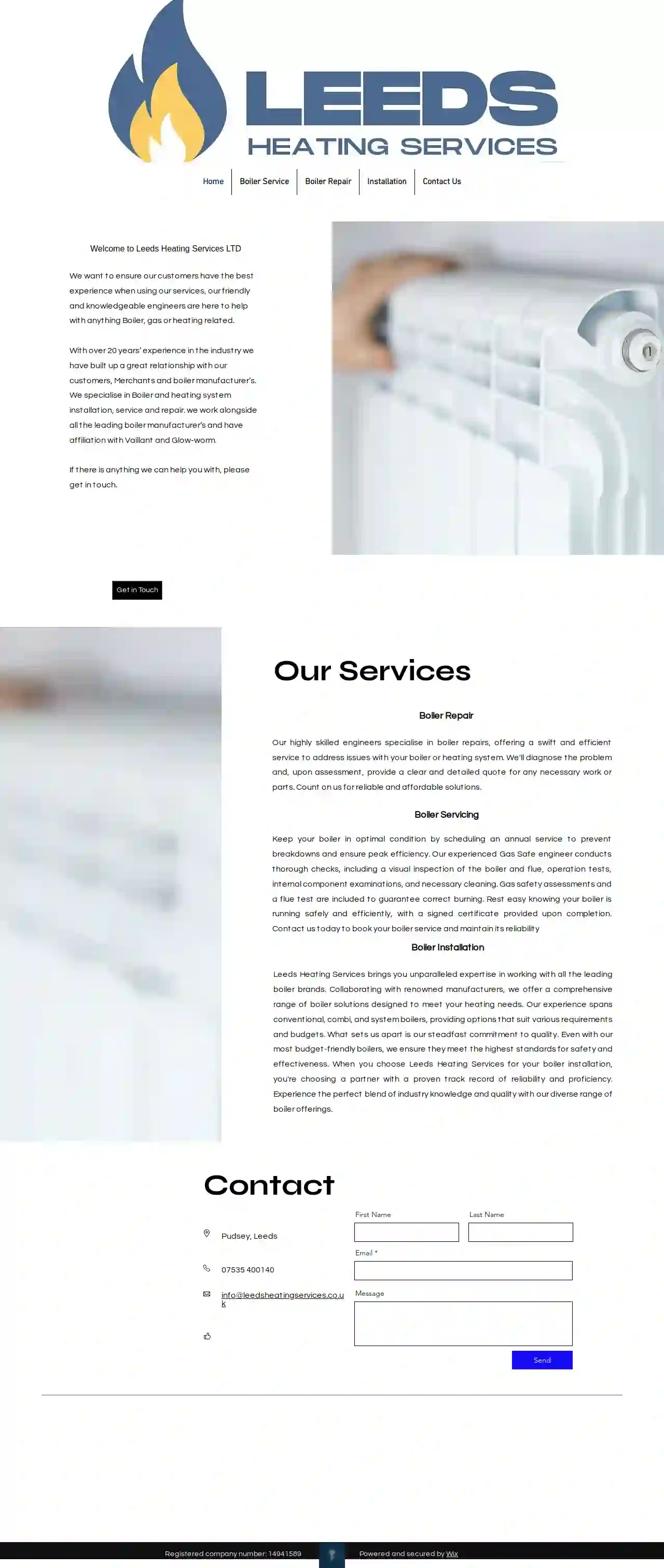
Leeds heating services ltd
53 reviewsPudsey, GBWelcome to Leeds Heating Services LTD. We want to ensure our customers have the best experience when using our services, our friendly and knowledgeable engineers are here to help with anything Boiler, gas or heating related. With over 20 years’ experience in the industry we have built up a great relationship with our customers, Merchants and boiler manufacturer’s. We specialise in Boiler and heating system installation, service and repair. we work alongside all the leading boiler manufacturer’s and have affiliation with Vaillant and Glow-worm. If there is anything we can help you with, please get in touch.
- Services
- Why Us?
- Gallery
Get Quote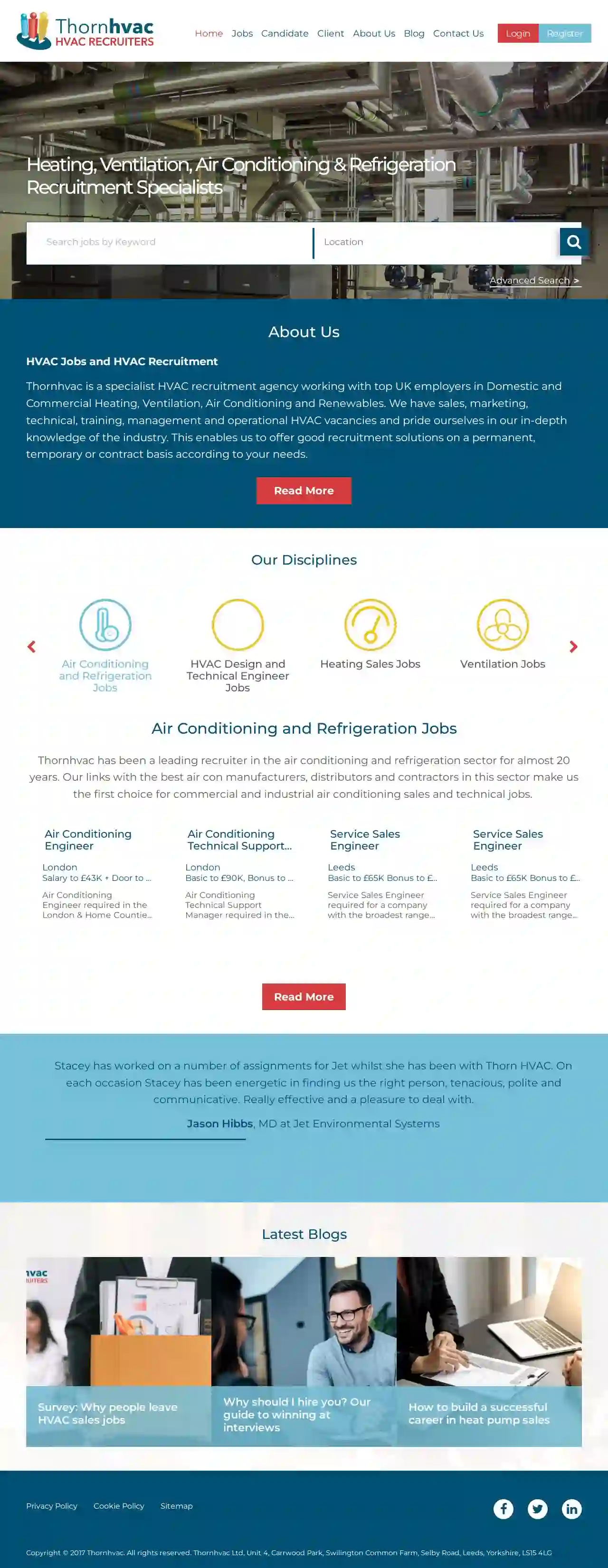
Thornhvac
4.612 reviewsUnit 4, Carrwood Park, Swillington Common Farm, Selby Road, Leeds, LS15 4LG, GBThornhvac is a specialist HVAC recruitment agency working with top UK employers in Domestic and Commercial Heating, Ventilation, Air Conditioning and Renewables. We have sales, marketing, technical, training, management and operational HVAC vacancies and pride ourselves in our in-depth knowledge of the industry. This enables us to offer good recruitment solutions on a permanent, temporary or contract basis according to your needs.
- Services
- Why Us?
- Gallery
Get Quote
TD Cooling Services - Leeds
1Building 3, Leeds City West Business Park, Gelderd Road, Leeds, LS12 6LN, GBTDC is a company specialising in the design, installation and maintenance of Air Conditioning, Refrigeration and Ventilation systems. We provide these services to our customers throughout the UK, from our main offices based in Chester and Leeds. We work across many industry sectors, including Power generation, Aviation, Healthcare, Pharmaceutical, Schools and Construction. We have an extensive, and growing, client list ranging from large multinational companies to small local business. We aim to build a collaborative working relationship with our clients, customers and suppliers in order to deliver an excellent level of service.
- Services
- Why Us?
- Gallery
Get Quote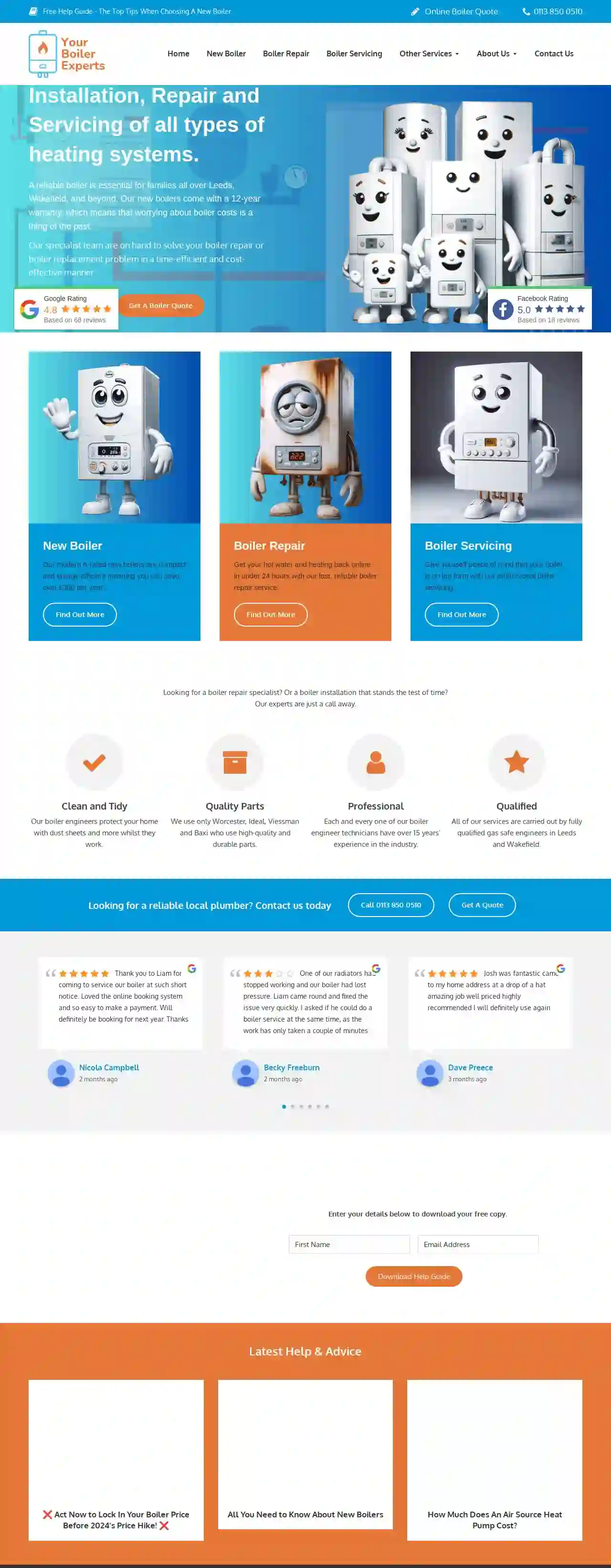
Your Boiler Experts
4.967 reviews2 North View, Rothwell, LS26 0BQ, GBYour Boiler Experts is a reliable boiler installation, repair, and servicing company based in Leeds and Wakefield. Our team of experienced and qualified gas safe engineers are dedicated to providing top-notch services to ensure your home is warm and comfortable. With a 12-year warranty on our new boilers, you can rest assured that your boiler is in good hands. We offer a range of services, including boiler repair, boiler servicing, and new boiler installation. Our team is committed to providing fast, efficient, and friendly services to our customers. We use only high-quality and durable parts from reputable brands such as Worcester, Ideal, Viessman, and Baxi. Our services are designed to meet the needs of our customers, and we strive to provide the best possible experience. Contact us today to schedule your boiler service or repair.
- Services
- Why Us?
- Accreditations
- Our Team
- Testimonials
- Gallery
Get Quote
Over 1,991+ HVAC Contractors onboarded
Our HVAC companies operate in Leeds & surroundings!
HVACCompaniesHub has curated and vetted the Best HVAC Contractors near Leeds. Find the most reliable contractor today.
Frequently Asked Questions about Furnace Repair
- Maintenance: Regular maintenance significantly impacts the life of your furnace. Annual checkups and timely repairs are essential.
- Usage: Frequent or continuous use puts more strain on your system.
- Quality: Higher-quality furnaces from reputable brands are typically more durable.
- Proper Installation: Correct installation is key to longevity.
- Pilot light or ignition problems: If the pilot light is out, the burners won't light, and the furnace won't produce heat. Ignition issues are a common culprit.
- Thermostat issues: An incorrectly set or malfunctioning thermostat can prevent the furnace from turning on or make it blow cold air. Check that your thermostat to ensure the system is set to 'heat' and the temperature setting is higher than the current room temperature.
- Overheating: If the furnace overheats, a safety switch may shut off the burners, causing the blower to circulate cold air.. Overheating can also damage your furnace, so it's best to have a professional inspect the system.
- Ductwork problems: Seal any ductwork leaks to improve performance. This can also result in the furnace blowing cold air, especially if the leak is near the beginning of the ductwork run.
What is the average lifespan of a furnace?
How often should I get my furnace inspected?
How often should I change my furnace filter?
Why is my furnace blowing cold air?
What is the average lifespan of a furnace?
- Maintenance: Preventative maintenance significantly impacts the lifespan of your furnace. A preventative maintenance plan can make your furnace more reliable.
- Usage: Frequent or continuous use puts more strain on your system.
- Quality: Higher-quality furnaces from reputable brands are typically more durable.
- Proper Installation: Correct installation is key to longevity.
How often should I get my furnace inspected?
How often should I change my furnace filter?
Why is my furnace blowing cold air?
- Pilot light or ignition problems: In older furnaces, the pilot light needs to be lit for the burners to ignite. Ignition issues are a common culprit.
- Thermostat issues: An incorrectly set or malfunctioning thermostat can prevent the furnace from turning on or make it cycle improperly. Check that your thermostat is set correctly and is sending a signal to the furnace to turn on.
- Overheating: If the furnace overheats, a safety switch may shut off the burners, causing the blower to circulate cold air.. This is typically caused by a restricted airflow, often due to a dirty air filter.
- Ductwork problems: Leaks in your ductwork can allow heated air to escape into unconditioned spaces, reducing the amount of warm air that reaches your rooms.. This can also result in the furnace blowing cold air, especially if the leak is near the beginning of the ductwork run.